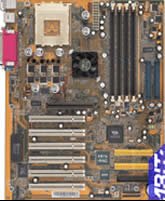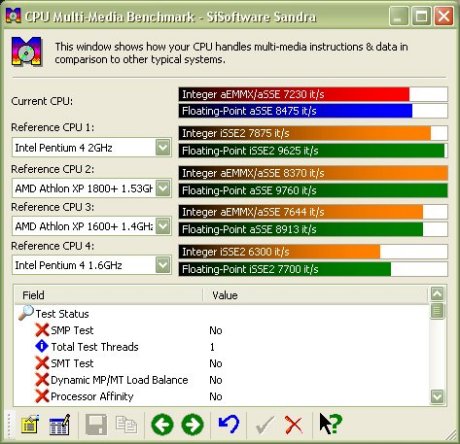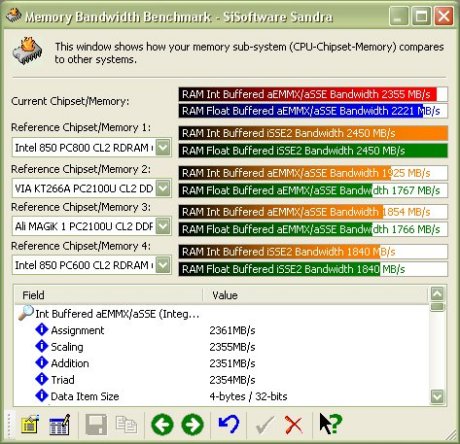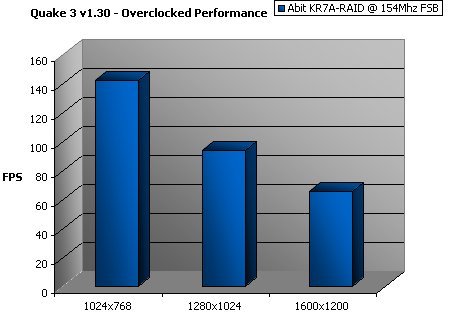|
Introduction
I remember first using a motherboard with a VIA chipset when I had my Abit KT7-RAID and old Duron 650. The board used VIA's KT133 chipset and supported Socket A processors, PC100 or PC133 SDR SDRAM and was the overclockers board of choice at the time. It was my first foray into the world of AMD processors and coming from an Abit BP6 and dual 433 Celerons @ 598 it was a decent system.
Time flies however and many many Socket A boards later I've arrived here today with the Abit KR7A-RAID. In these past 12 months since the KT133 chipset, we've seen the emergence of some crucial new technologies to partner AMD's Socket processors, mainly in the form of memory bandwidth enhancements.
An Athlon or AthlonXP at 133Mhz FSB can take advantage of around 2.1Gb/sec of memory bandwidth provided the host memory subsystem can provide it. The KT133 with SDR SDRAM couldn't quite get there with just over 1Gb/sec on tap at 133Mhz memory clock.
DDR memory technology, where data is available on the rise and fall of the clock signal driving the memory module and memory controller, has taken off in a big way since its release and it's now almost impossible to buy a new AMD system without DDR memory. With DDR the processors now have the 2.1Gb/sec that they crave (although not completely since the other peripheral busses require some too) and further technologies like NVIDIA's TwinBank where there is a maximum of 4.2Gb/sec available are helping the platform mature and gain performance.
While NVIDIA forge ahead with TwinBank, giving the CPU 2.1Gb/sec and still leaving 2.1Gb for the rest of the system, hopefully maximising memory performance, VIA have taken a different route, preferring to further optimise the memory controller in the KT266 to create the KT266A. KT266 was criticised for poor memory bandwidth pretty much from day one so VIA spent the time increasing the efficiency of the controller to extract more from what's already there. VIA have been extremely coy over the exact nature of the improvements but an Anandtech article here hazards an educated guess at what VIA did to the Northbridge to create KT266A (Southbridge is unchanged). Anand takes a guess that the internal data buffers in the chipset have been deepened, allowing a more uninterrupted data flow between CPU and the memory controller and on to main system memory.
So it's with this new, enhanced version of the KT266 that Abit have used to create the KR7A-RAID. Abit skipped the KT266 entirely unlike many manufacturers that brought out KT266 boards and are now updating their product lines with updated boards. VMAP helps here since the new Northbridge is a pin compatible drop in upgrade and should require only a BIOS upgrade to work.
Abit were a bit later to market than most with the KR7A-RAID just like they were with the KG7 series boards. They come in for criticism about not having products available for general retail sale at the same time as their competitors but it usually means they are just taking the extra time to perfect their boards. The KG7 was an excellent AMD761 implementation and so the KR7A should follow on and be an excellent implementation of the KT266A chipset.
So lets take a peek at the board itself and see what AMD have done with the chipset.
Abit KR7A-RAID
CPU
Support AMD Athlon XP 1500+ ~1900+/AMD Athlon 700MHz~1.4GHz or future Socket A Processors based on 200/266MHz (100MHz/133MHz Double Data Rate)
Support AMD Duron 600MHz ~ 950 MHz or future Socket A Processors based on 200 MHz (100MHz Double Data Rate)
Chipset
VIA KT266A / VIA VT8233
Memory
Four 184-pin DIMM sockets support up to 4 GB PC1600/PC2100 DDR SDRAM module
BIOS
SoftMenu™III Technology to set CPU parameters
Functions
Four channels of Bus Master IDE Ports supporting up to 8 Ultra DMA 33/66/100/133( RAID 0 /1/0+1).
Miscellaneous
1 AGP slot, 6 PCI slots.
Ultra DMA 133/RAID
High Point HPT372 IDE Controller
Ultra DMA 133MB/sec data transfer rate
On first look it doesn't seem like Abit have done that much extra with the KR7A with it being a fairly bog standard specification with only the KR7A-RAID having anything very interesting on board in the form of the Highpoint HPT372 ATA133 RAID controller. Apart from that it's fairly standard stuff.
ATA133 RAID is debatable in its usefullness due to the vast majority of IDE drives being unable to transfer anywhere near the 133Mb/sec ceiling of the spec, even in the quickest RAID configuration with more than one disk. However its inclusion on any motherboard isn't unwelcome since you are very free to use ATA100 or even ATA66 disks on the controller and it will work perfectly well.
Layout and Installation

Layout is pretty similar to the KG7-RAID with it's 4 DIMM slots (no restrictions on DIMM order this time). Starting at the top left as usual we hit the CPU socket. There is decent room to the left and right of the socket but underneath the socket by the 3 lugs are a 3 large capacitors. However an Alpha 8045 did fit fine with no clearance issues and being one of the largest Socket A coolers on the market I presume that pretty much anything will fit without a problem.
Moving along the top edge we hit 2 more capacitors before coming across 2 CPU fan connectors flanked very closely with the vertically oriented ATX connector. In practise it was quite fiddly to attach fans to the headers even without the ATX power cable plugged in since there is very little room around the headers. Something to watch out for.
Next we hit the 4 DIMM slots that hove no order restrictions unlike on the KG7-RAID and the DIMM's can be populated with unbuffered or buffered memory unless you are using all 4 slots in which case buffered memory must be used.
We find the southbridge provided IDE ports aligned vertically next to the bottom of the 4th DIMM slot. The RAID ports are located in the bottom right of the board with the floppy port underneath, all three horizontally aligned. It's a pet hate of mine for the floppy port to be placed and aligned like it is here but given a long enough cable it shouldn't pose too many problems. Recently on my test system I've taken to just using a bootable CD that runs DOS and enough drivers and tools so that I can get any operating system started or partition and manipulate any of my disks. This removes the need for a floppy drive altogether since booting is all I use them for. However, beware of the location and orientation of the port if you need to use it.
Apart from that awkward layout, everything else is standard. ATX case headers are in the bottom right area and the 6 PCI and AGP slot are of course placed according to the ATX specification. Also, the board uses the full 9 hole ATX mount system, however the farthest right 3 holes didn't match to any holes on my YY Cube case. I'm not entirely sure if they are correct with regards to the ATX specification and the board worked fine without them being used to mount the motherboard. I just had to be careful with regards to a small amount of flex in the PCB when attaching anything to the IDE ports.
BIOS, Manual and Bundle
The BIOS is the usual AWARD BIOS with Abits own SoftMenu III addition for tweaking CPU and performance parameters for the system. The tweaking options are of course generous as is usual with SoftMenu III equipped boards. You have CPU volt adjust to 1.85V, DDR memory volt adjust to 2.85V and chipset voltage adjust. You can also adjust DDR timings and AGP and PCI timings and options. The board is very tweakable and like all Abit boards you have no jumper adjustment to worry about. Eminently tweakable and up to Abits usual high standards.
The manual is typical Abit, easy to read, easy to find what you need, good diagrams and well written. No faults with the manual at all. The bundle isn't that impressive with just the board, manual, CD, RAID driver floppy disk and the usual IDE cables in the box. I was hoping for the usual USB ports too, but they weren't present. It was a review sample however and I'm sure they are included in the proper retail box. The box itself follows Abit new design and was the red and white type (I've seen blue before too).
Performance
I've had a pretty special CPU here at Hexus for a short while for review and it was reviewed using this motherboard. More on that later. For the purposes of this review however I reverted to my XP1500 to retain parity with recent AMD based reviews here at Hexus. Cooling was my usual Reactor waterblock hooked up to an OCH Blizzard kit using a Fusion II radiator.
Test System
- Abit KR7A-RAID Socket A AMD Motherboard
- AMD XP1500 Processor (1333Mhz)
- 256Mb Crucial PC2100 DDR CAS2.5 module @ CAS2
- Gainward Ti550 GeForce3 Ti500 (240/500)
- Adaptec 39160 PCI SCSI Dual Channel U160 controller
- 2 x 73Gb Seagate Cheetah 73LW U160 10,000rpm SCSI disks
- Plextor 12/10/32S SCSI CDRW
- Windows XP Professional Build 2600.xpclient.010817-1148
- DetonatorXP 22.40 NVIDIA drivers
- Aquamark v2.3
- Quake3 v1.30
- POVRay v3.1g.msvc.unofficial-win32 dated 28 August 2001
- 3DMark 2001 Professional
- SiSoftware Sandra v2002.1.8.59
Sandra is the full retail version of version 2000 Professional whereas previously we were using the German beta (v2002.0.8.57) of 2002 Professional. Benchmark results are directly comparable however.
Performance at 1333Mhz (10 x 133)
As usual to start off our look at performance we have Sandra numbers.



The CPU marks are spot on, nothing to get worked up about. The memory benchmark is slightly above what Sandra expects for the chipset and is possibly due to timing improvements made by Abit before release. Sandra reports 95% efficiency which is highly impressive. While that certainly isn't the case in the real world, it still shows the best case which is impressive without a doubt.
POVRay next for comfirmation the CPU is working properly.

Anything around 54s is spot on for a 1333Mhz Athlon XP1500 so the processor is performing perfectly in the KR7A-RAID. For reference, running the P3 binary as we do here on a 2Ghz Pentium 4 (20 x 100) gives a render time of 55s for our test scene (pawns.pov, part of the standard POVRay distibution). We can see what the increased IPC does for the processor here despite a far lower clock speed.
3DMark gave us a result of 7480 out of the box, slightly ahead of the 7450 of our test NForce (MSI K7N420 Pro) and XP1500 with GeForce3 Ti500. Nothing much in it but it shows the Abit performs very well, quicker even than NVIDIA's flagship performance chipset. Here we can see the KT266A being put to good use and used well without any tweaking at all. Tweaking of card clocks and driver options would take us over 8000 3DMarks.
Aquamark next. Based on Aquanox, Massive Developments underwater action game, Aquamark is a short graphics intensive benchmark that makes heavy use of DirectX8 class rendering features. Lack of a DX8 card here will show up easily. Thankfully we have Gainwards excellent Ti550 Golden Sample under the hood (clocked at stock Ti500 clocks of 240/500).
AquaNox - AquaMark V2.3 2001/11/20 - (c) Massive Development
------------------------------------------------------------
RESOLUTION : 1024x768x32
FSAA : NONE
PIXELSHADER: YES
TEXTURE : 24MB
SECONDS : 43.48
......
MIN FPS : 34.1
MAX FPS : 72.9
AVG FPS : 51.9
We are using the same configuration as our NForce test bed including the same drivers and we are scoring 6fps, not insignificant in Aquamark terms. Given the same overall clocks we can conclude that Abit are doing something right on the KR7A-RAID with the KT266A. +50fps is our target Aquamark score at the moment and the KR7A-RAID does that pretty easily on a comparatively slow CPU.
Quake 3 for our final game based benchmark. OpenGL based and not reliant on any DX8 class features (the engine was originally a render target for GeForce class hardware and runs on old Rage Pro's too!) it runs incredibly well on this class of hardware.

The NForce is a few FPS faster here, especially at 1024x768 but there isn't really much in it. Over 60fps @ 1600x1200 is the magic number here. Remember, we turn on every single performance sapping feature while running our Quake3 benchmarks. A full 60fps average at such a high resolution with everything on is excellent.
So stock performance is excellent out of the box. The KT266A shows its true speed here and with such a relatively slow clocked CPU too. It beats the NForce in all our test benchmarks bar Quake3 and even then is only beaten by a small amount. The best Socket A AMD performance we've yet seen at Hexus out of the box.
Overclocked Performance
Abit boards are traditionally good overclockers and the KR7A-RAID is no exception. However during its stay in the test system with the XP1500 the waterblock fitment didn't seem to be perfect and temperatures were high. That said, the XP1500 was decently overclocked to 1540Mhz (154Mhz FSB, 10x multiplier). I was hoping for higher since the processor has done closer to to 1.8Ghz before but given the length of time testing with the board and using the XP1500, 154fsb was the highest I could manage. This was with all performance enhancing options on in the BIOS including 4-way interleaving, 2-5-2 memory timings, CAS2, 1T command, Ultra etc. I'll show a few benchmarks at 1540Mhz then a result using a different CPU on the same board to show you what it's really capable of.
First off, the Sandra memory bench. The CPU benchmarks are exactly where they should be for a 1540Mhz AthlonXP so I wont bore anyone with them.

At 154Mhz memory clock we are again seeing roughly 95% utilisation of the available performance from the memory controller. While it's only a synthetic benchmark and real world performance is some way off this ideal figure when using common apps, it's still quite impressive to see that when pushed, the chipset and memory controller can produce such impressive numbers. Unfortunately it is a very small number of applications that need bandwidth that high. Games are often the usual culprits since they are the main drivers of hardware innovation these days. The graphics industry moves faster than the CPU industry at the moment and it's all down to games.
Aquamark was a little different and didn't seem to respond to the clock and FSB increase very much at all. Being heavily dependant on the DX8 rendering features on the graphics card, increasing card clocks would have had a bigger effect, however the increase is there nonetheless.
AquaNox - AquaMark V2.3 2001/11/20 - (c) Massive Development
------------------------------------------------------------
RESOLUTION : 1024x768x32
FSAA : NONE
PIXELSHADER: YES
TEXTURE : 24MB
SECONDS : 41.33
......
MIN FPS : 32.7
MAX FPS : 75.6
AVG FPS : 54.5
Only a 3.6fps increase for our 21Mhz increase in FSB and 210Mhz increase in external CPU clock. As we mention above, Aquamark also responds a bit better to increases in the processing speed of the graphics card so overclocking the Gainward here would have a more pronounced effect on the score.
Finally Quake3 to show what an increase in CPU clock and memory bandwidth has on the speed of the game.

While the graph doesn't show it very well, performance at 1024x768, our lowest test resolution, is over 140fps at 142.6fps. As we increase the resolution and therefore the dependance on card fillrate, the increase in performance for the overclocked system becomes less and less. Increasing card clocks along with the system overclock would further increase performance.
So while the motherboard wasn't able to take the XP1500 very high due to heat issues we can still examine the performance increases we did get. It's worth noting that at 154Mhz FSB, even with the most aggressive performance options enabled in the BIOS, the system was perfectly stable for all the tests. Granted testing time was short but nonetheless no problems were encountered.
Overclocked performance at 154Mhz was impressive and the increase in memory bandwidth at the new speed was very welcome since the processor front side bus also increased and with it the amount of memory bandwidth it can access.
I mentioned at the start of the performance section of this review that I had been reviewing a special AMD processor for Hexus using this motherboard, the fastest AMD board I had to hand. The processor was the Athlon XP2000 (1667Mhz) and using the Reactor waterblock and normal room temperature cooling the quickest the processor could run at was around 1800Mhz @ stock voltage.
With the review out of the way and couple of days to spend with the processor pushing it a bit further, I decided to see if I could break my personal 3DMark best of 9682 (WindowsXP, 1800Mhz, XP2000 @ 144Mhz x 12.5, GF3 @ 265/265) and push for 10000 3DMarks. While the overall front side bus speed would be low due to the high locked multiplier of 12.5x, I still thought 10000 would be possible.
Using cold air to chill the water passing through the radiator I was able to drop the temperature of the processor to around 20c load, regardless of CPU speed. The only thing limiting things were the processor itself and the motherboard. 1887Mhz with a front side bus of 151Mhz was achieved as the stable benchmarking speed with the processor itself booting into Windows 98 at speeds of up to 1950Mhz. Not bad for AMD's new baby and simple watercooling. Here's the fruits of the labour.

9982 3DMarks (sadly not a full test) isn't bad for a couple of hours work in the cold with the air chilling the water. Configuration was the KR7A-RAID, XP2000, Windows 98, DetonatorXP 22.40 drivers, VIA AGP 4.10 driver, DirectX 8.0 and 3DMark 2001 Professional. The drivers were tweaked for speed over image quality. Check out the Compare URL for the 9982 result here and also the Compare URL for the old 9682 WindowsXP result here (full test).
Not really an every day setup but it shows you what the motherboard can do when pushed and what a little watercooling can do for your overclocks.
Overall performance and stability was excellent at higher than 150Mhz FSB with all the performance options and timings enabled. Memory timings were always at their most agressive and everything was rock solid. Stability was superb.
Conclusion
So what was the board like overall? First impressions aren't exciting. The board is no frills, stock layout, stock bundle, average features. It's all staid and solid from first impressions. Not like MSI's red K7T266 Pro2 RU with loads of extras and striking PCB or the Soyo Dragon Plus we'll be covering shortly with coloured PCB, onboard everything and excellent bundle.
However performance is excellent when you get it tweaked to the best of its ability. It wouldn't recognise the XP2000 (BIOS update needed) so manual setting of 13x in the BIOS (no 12.5x setting) was required to get the CPU booting, something not obvious at first boot with that CPU. It was quicker than NForce and quicker than the other KT266A board we have tested, the Pro2 RU from MSI.
It's only extra feature is the ATA133 RAID controller on the RAID version so unless you buy that version of the board, it's just a very high performing KT266A design which was very stable at all speeds. 4 DIMM's is useful for those looking to build a serious workstation around the board and pack it with memory.
Overall it was a pleasure to use, but nothing special, except in the performance. It seems like the extra time spent by Abit has paid off, not in feature count but in stability and performance. An excellent board, highly recommended for the performance enthusiast.
|